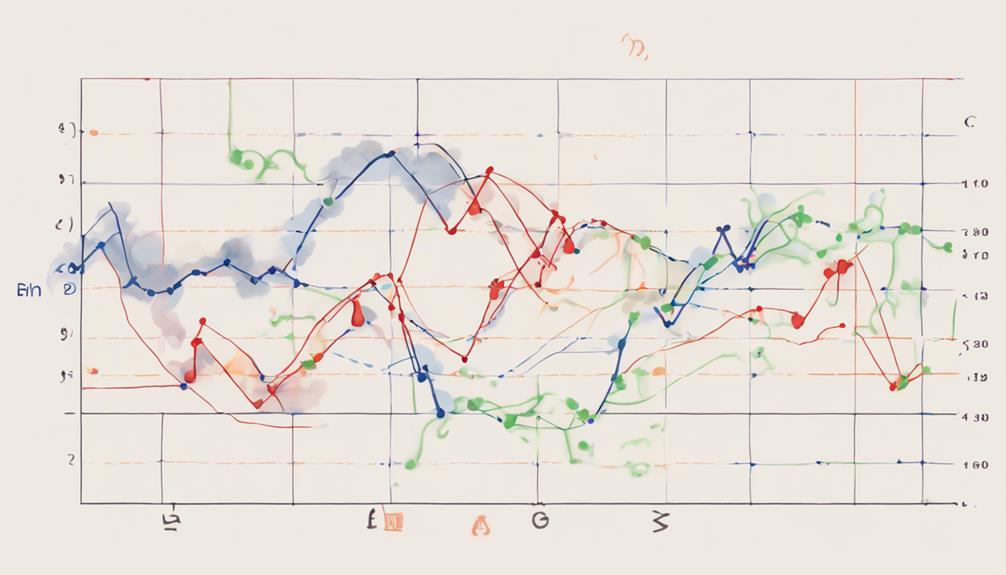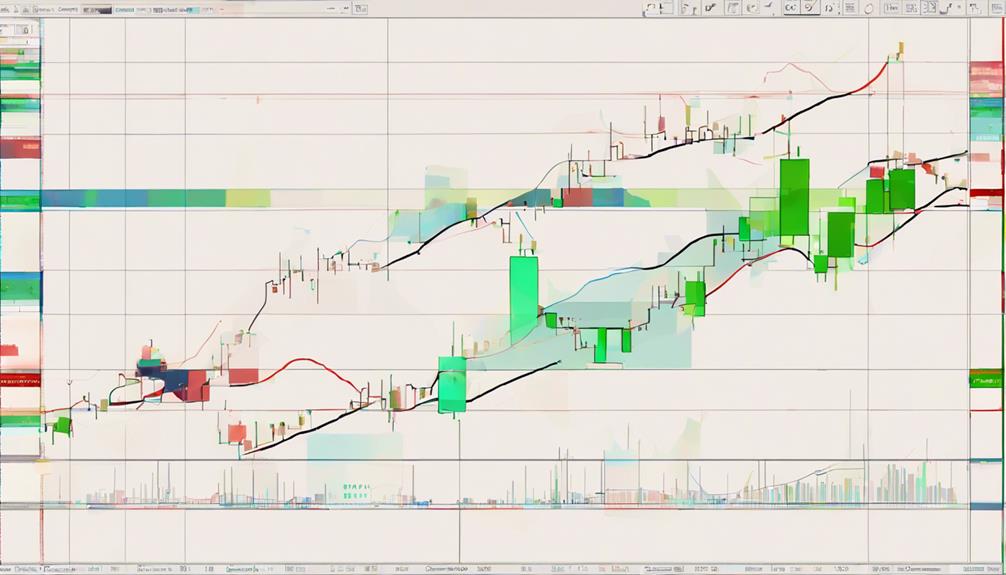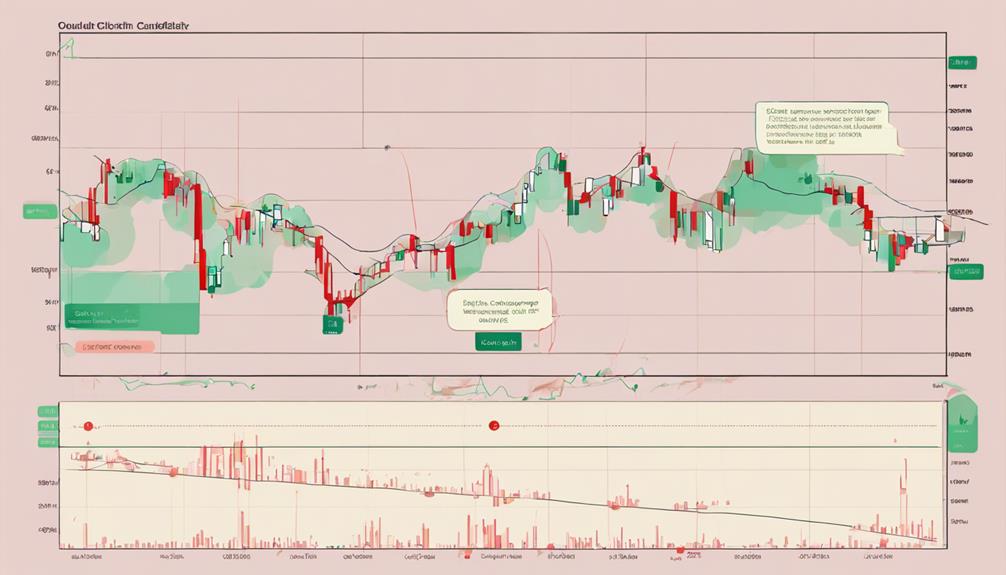So, you've heard about the Ichimoku Cloud indicator and its mystical abilities to reveal market secrets, but how do you actually make sense of those wavy lines and colorful clouds?
Well, fear not, as we're here to demystify this complex tool and break it down into manageable chunks for you. By understanding the key components and interpreting the signals it generates, you'll be equipped with a powerful tool to navigate the dynamic world of trading.
But wait, there's more to uncover beyond the surface of this enigmatic indicator that could potentially transform your trading strategies.
Understanding the Ichimoku Cloud Indicator
Developed by Goichi Hosoda in the late 1960s, the Ichimoku Cloud indicator is a comprehensive tool for traders seeking insights into market dynamics.
The Ichimoku Cloud comprises key components such as Tenkan-Sen, Kijun-Sen, Senkou Span A, Senkou Span B, and Chikou Span, serving as a visual aid to identify support and resistance levels.
This indicator offers a holistic view of market behavior, enabling traders to analyze trends and potential entry/exit points efficiently.
Calculating the Ichimoku Cloud

To accurately compute the Ichimoku Cloud, traders must calculate key components such as the Tenkan-Sen and Kijun-Sen. The Tenkan-Sen is derived from the average of the highest high and lowest low over the previous 9 periods, while the Kijun-Sen is calculated using the average of the highest high and lowest low over the past 26 periods.
Additionally, Senkou Span A is determined by averaging the Tenkan-Sen and Kijun-Sen, plotted 26 periods ahead, and Senkou Span B is calculated by averaging the highest high and lowest low over the last 52 periods, also plotted 26 periods ahead. The Chikou Span completes the calculation by plotting the closing price of the current candle 26 periods back on the chart.
Interpreting Ichimoku Cloud Signals

When analyzing Ichimoku Cloud signals, observe the relationship between price and the cloud to gauge bullish or bearish momentum. A crossover with the Tenkan-Sen line crossing above the Kijun-Sen line indicates a buy signal, while the opposite suggests a sell. Additionally, the Chikou Span's position in relation to historical price action confirms the price direction.
The cloud's thickness acts as a visual representation of support and resistance levels, crucial for making informed trading decisions. By monitoring crossovers, Chikou Span position, and changes in cloud color, you can accurately interpret Ichimoku Cloud signals and anticipate potential market movements.
Stay vigilant and use these key indicators to guide your trading strategies effectively.
Utilizing Ichimoku Cloud in Trading

Observing the Ichimoku Cloud components in trading allows for the identification of trend directions and potential reversal points, aiding traders in making informed decisions.
The Conversion line and Base line can be utilized for trade exits based on risk tolerance levels.
Integrating Ichimoku Cloud with support/resistance levels and price action analysis can enhance trading strategies, providing a comprehensive view of market conditions.
Following the trend direction indicated by the Cloud is essential for executing successful trades consistently.
Advantages and Limitations of Ichimoku Cloud

The Ichimoku Cloud indicator offers traders a comprehensive analysis tool with clear visual insights, allowing for versatile application in market assessment. Ichimoku Cloud offers a unique perspective by incorporating multiple lines such as the Conversion Line, Base Line, Leading Span B, and the Span. These lines provide valuable information on trend direction and momentum, helping traders identify potential support and resistance levels.
While the indicator excels in offering a holistic view of the market, its lagging nature and the subjective interpretation required can be limitations. Understanding these trade-offs is essential for effective use. Combining the Ichimoku Cloud with other technical indicators can enhance the accuracy of trade signals and improve decision-making in trading strategies.
Can I Use the Simplified Guide to Understand the Ichimoku Cloud Indicator?
Yes, you can use the ichimoku cloud indicator simplified guide to understand this popular technical analysis tool. This guide breaks down the complex concepts and components of the ichimoku cloud indicator into easy-to-understand terms, making it accessible for traders of all levels.
Frequently Asked Questions
How Do You Read Ichimoku Cloud Indicator?
To read the Ichimoku Cloud Indicator, analyze the position of price relative to the cloud, watch for Tenkan-Sen and Kijun-Sen crossovers, and note Chikou Span's location. The cloud's color and width indicate support/resistance strength.
What Are the 5 Lines of the Ichimoku Cloud?
Glide through the market with clarity. The five lines of the Ichimoku Cloud are your guides: Tenkan-Sen, Kijun-Sen, Senkou Span A, Senkou Span B, and Chikou Span. They reveal trends, momentum, and possible signals.
What Is the Basic Ichimoku Strategy?
To grasp the basic Ichimoku strategy, monitor Tenkan-Sen and Kijun-Sen line crossovers for entry/exit signals. Confirm trends using Chikou Span. Seek price breaking cloud for trend validation. Manage risk prudently. Success demands practice and understanding.
What Is the Best Time Frame for the Ichimoku Indicator?
For the Ichimoku indicator, the best timeframe varies based on your trading preferences, risk tolerance, and analyzed market. Experiment with different timeframes to find what suits your strategy best, enhancing signal accuracy.
Conclusion
In conclusion, the Ichimoku Cloud indicator is a powerful tool for traders seeking comprehensive market analysis. By incorporating various components and calculations, it offers valuable insights into trends, support/resistance levels, and potential buy/sell signals.
With its ability to provide a holistic view of market behavior, traders can make informed decisions and stay ahead of market trends. Keep exploring the Ichimoku Cloud's capabilities to enhance your trading strategies and maximize your profits.
